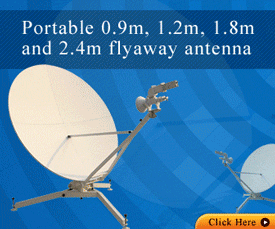How to select VSAT antenna system band and aperture
How to select VSAT antenna system band and aperture
1. Band selection.
At present, band used by VSAT system have three categories which are 4/6 GHz at C-band, 12/14GHz at Ku-band, 20/30GHz at Ka-band. C-band has the advantage of mature technology and stable space transmission and the disadvantage that it can easily interfere with ground microwave of the same band and its location is limited greatly when used in cities. Ku-band has the advantage that it doesn’t have interference with ground microwave of the same band and it has smaller aperture and easy location, the disadvantage of unstable space transmission. Therefore, there is a need to keep enough link margin for Ku-band when designing the system. Ka-band is not applied broadly at present because of limited channel resource and complicated technology. C-band is generally available for voice transmission while Ku-band is generally available for data transmission. However, this is not absolute. Ku-band will become the main band in the later period of the 90s because of continuous increase of Ku-band repeater.
2. Selection of antenna aperture.
Satellite antenna aperture is closely related to quality factor(G/T value)of earth station. G/T value and satellite power demand, i.e. equivalent rent bandwidth, show logarithmic linear relationship. In other words, the value of equivalent rent bandwidth increases with the narrowing of antenna aperture. Therefore, when selecting earth station aperture, it is not the smaller, the better. And earth station aperture should make a compromise between space overhead (equivalent rent bandwidth) and ground overhead (antenna aperture) to make system achieve optimum allocation.
This article is provided by the engineer from Antesky Inc


